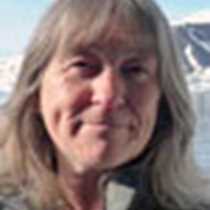Northern Svalbard
In the far north of Spitsbergen lies a small bay, facing out to northwest from the mouth of Wijdefjorden. On an exquisitely tranquil day like today it is all peace and serenity. Purple sandpipers browse the tangle on the shore for tasty morsels; the bubbling song of the snow bunting delights our ears; a red-throated diver circuits over its lagoon; our kayakers slide through unrippled water. This is Mosselbukta on a high Arctic summer’s day. But the storm beach of upcast stones and enormous Siberian logs belies the idyllic scene, testifying instead to the powerful forces of wind and ice that shape this land.
In the year 1872, the first scientific overwintering expedition to Svalbard came upon this spot and chose it for their headquarters. Under the leadership of Adolf Erik Nordenskiöld (who later discovered the north-east passage), this well-prepared team established base on its rocky headland. However, the night before their two supply ships with forty-four sailors were due to depart, they were all trapped by surging storm-driven sea ice and stranded for eleven months, before a channel could be cut through the melting ice to release the battered ships to sail home. Despite the constant threat of scurvy, they mostly survived well and their scientific achievements were considerable, although their intended expedition north across the polar sea ice by reindeer-drawn sledges proved impossible. Today the foundations of their house, three observatories, and remains of 3,000 sacks of reindeer fodder are the memorials of this epic undertaking.
Our morning explorations were followed by an inspiring afternoon with C.T. and the other photographers, and an early dinner, in preparation for our evening adventure on the island of Lågoya. This is a favourite haunt of the walrus, and we were able to creep up on dozens of the huge animals with their magnificent ivory tusks hauled out on the shore, dozing, scratching, grunting, while others could be observed in the surrounding waters. Abundant and rare birdlife was also everywhere: red-necked phalaropes and Sabine’s gulls, with nesting eider ducks and arctic terns. Growing among the dry stones on the flat terraces were brilliant patches of purple saxifrage. Evidence of past human lives was also present in the form of centuries-old whalers’ graves. It was amazing to stand in the hour before midnight on this low, bright jewel of an island with the panorama of the arctic all around us at the furthest north point of our odyssey, at an incredible 80° 27.4’ north.




